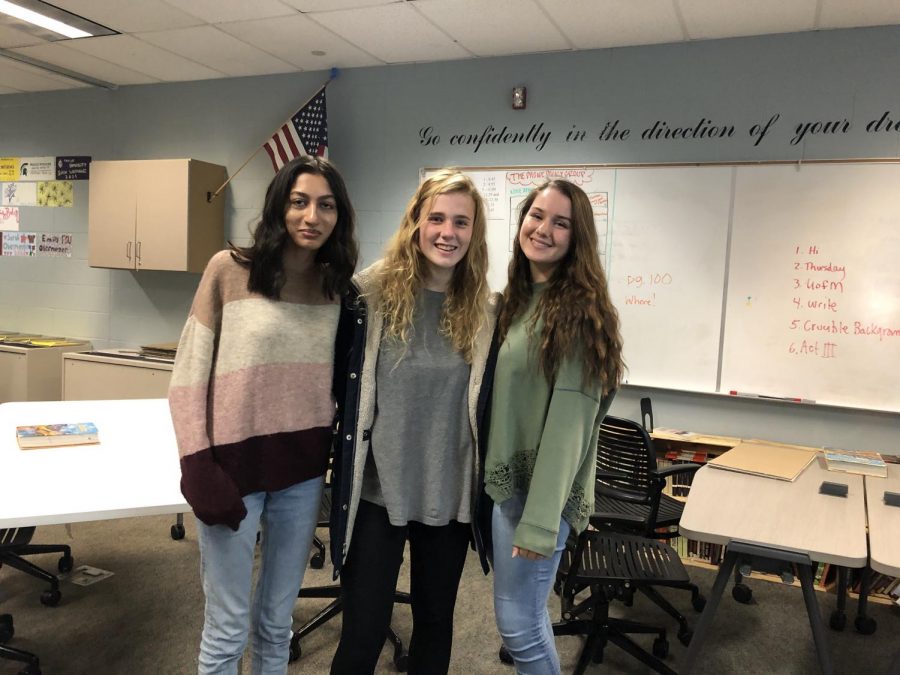This is not your ordinary math club
More stories from Elise Stine
The Academic Success Center is doing their tutoring in the media center. However, on the upper level of the school, three girls and a teacher are helping students with a single subject: math.
“[The ASC does] a wide variety of topics,” junior Amelia Pointer said. “We have pretty much focused on math. I have not actually been to ASC. I do not know what their style [is], but [the math club] feels a little bit more informal.”
Amelia, as well as juniors Valerie Greenwood and Ayesha Jeddy, is part of the math club. Instead of showing off how good they are at math by solving very difficult equations and math problems, they are using their intelligence to help the students who needed a little extra help in the world of math.
Valerie, who has been a part of the math club since last year, which had consisted of intelligent people solving very difficult equations, was the one to bring up the idea to alter the math’s club purpose to tutoring.
“I had been going to the previous math club for a while,” Valerie said. “But, it was going over my head a little bit. It was really smart kids who were really good at math doing really hard problems. I was not quite at that level yet, but I still wanted to be involved somehow. So when it kinda faded out last year, I got the idea of [changing] it so I could help kids that were struggling [and help them to] be more successful in school.”
Math teacher Daniel Garbowitz, who has been head for the past two years, believes that having a main focus will help the club immensely.
“In the last two years we had a math club going [but] it sort of fizzled out in the past year,” Garbowitz said. “Fewer and fewer students started coming; the students that did come did not have great ideas to keep the ball rolling. Some of those kids decided that they would do better if we had a focus, and that focus is helping students with their math work so that is where we have started this year.”
The girls are there to help students with math every Tuesday and try to make it the least stressful as possible, they claim their assistance to be low-pressure and a lot of fun.
“Garbowitz is such a fun teacher [and] so is the math, but then it is also just a good time,” Amelia said.
Ayesha and the others helped a troubled student after school on one of these Tuesdays. They not only gave this student the math help they needed, but they also gave the students emotional support.
“They were having a really hard time before a test,” Ayesha said. “We helped them with math and also kind of emotionally and let them know that things will be okay. [We make sure] they know all of the subject matter and that they are capable of doing it and getting a good grade.”
Valerie agrees with Ayesha, and she also thinks that talking to a teacher can be awkward at times.
“Right before a test you just need to have someone look you in the eyes and go ‘you know this, it is okay,'” Valerie said. “Being able to do that for somebody else felt good because they did not have to go up to their teacher, which is kind of awkward [because] they [say things like] ‘stop asking questions, just take it.'”
The trio and Garbowitz agree that student-to-student tutoring is the best way to go when it comes to helping students.
“I think students feel more comfortable asking other students than a teacher,” Garbowitz said. “So far, it’s been really beneficial. We have had a number of kids come in on Tuesday and get help from these three girls. It has gone really well.”
Valerie agrees with Garbowitz, and she also believes that asking a teacher is like a last resort or throwing in the towel.
“Going to a teacher feels like you’re giving up, like [you are saying] ‘I tried, I beat my head against the wall, and I couldn’t figure it out,’” Valerie said. “But going to students is just like, ‘Oh could you just clarify this really quickly?’ It is not formal, and we are going to sit down and tell you how to do everything.”
Amelia also concurs that students tutoring other students is the best way to go.
“[Students who have already learned] understand [the topic] differently than teachers,” Amelia said. “They figure out the patterns, so they can teach it to students in a way that students can understand—in a different way than teachers.”



























































































